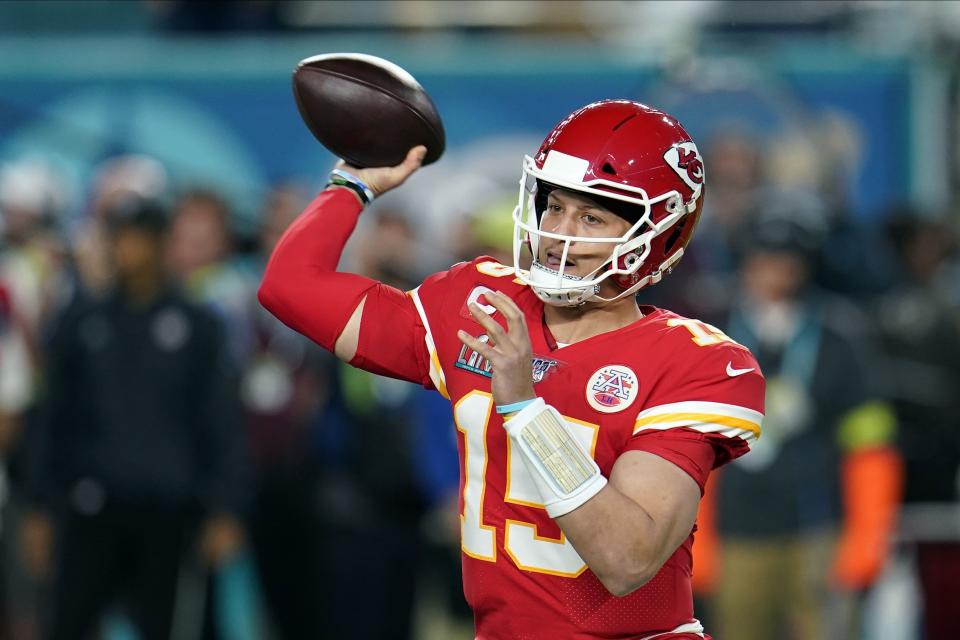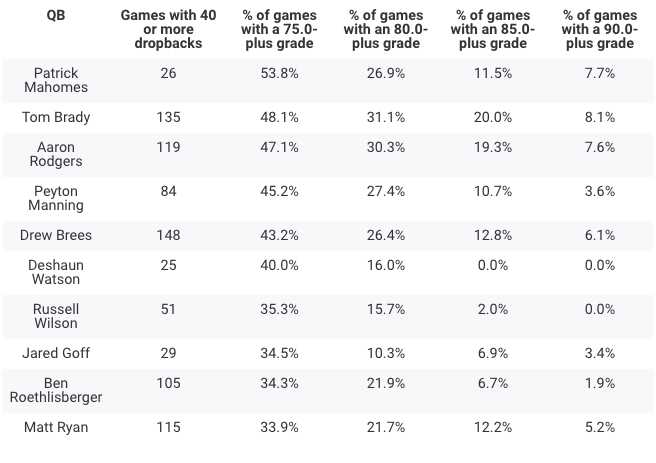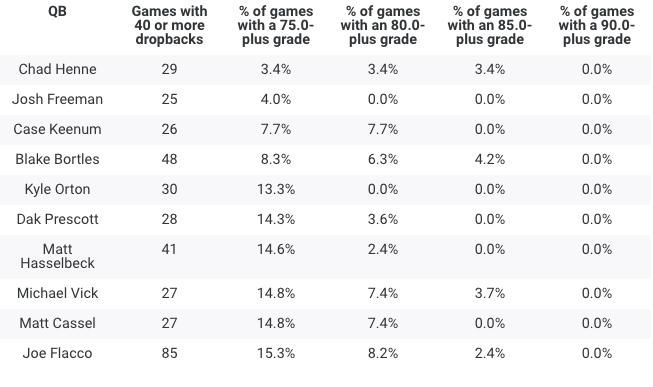NFL's best quarterbacks in pass-heavy games: Russell Wilson, Patrick Mahomes and more
By Sam Monson
About the only thing differentiating Russell Wilson from Patrick Mahomes right now is how much Mahomes’ team is prepared to give him the football and let him get to work.
In terms of PFF grade per play over the past two seasons, Wilson actually beats Mahomes (albeit narrowly). Wilson also had the highest PFF grade in the league last season, generated the most wins above replacement (PFF WAR) and led the league in several other statistical categories. Despite this, 14 quarterbacks have dropped back to pass more than Wilson over the past two seasons.
The Seattle Seahawks have tilted more run-heavy than any offense in the league outside of the Baltimore Ravens over that time, and they seem intent on taking the ball out of Wilson’s hands as much as possible.
It’s not that they think Wilson is a bad quarterback, it’s that they believe that he is at his best when he doesn’t have to throw 40-50 times a game. And based on the past two seasons’ worth of evidence, it would be hard to say that the Seahawks are wrong in their assessment. Wilson has taken his game to another level and been as good as any quarterback in the NFL on a per-throw basis, but is that because they have protected him with the run game or is it a coincidence?
When I looked at just how well Wilson has been playing, I took a cursory glance at his performance in games where the conservative plan had gone out the window and the Seahawks had to rely on his ability to pass.
Wilson has been better than average when it comes to grading above 75 when he drops back 40 or more times in a game, but he’s not on the same level as the very best quarterbacks in the game. He has just one such game with a PFF grade above 85 and no games with a 90-plus grade.
If you look at just the past two years, his numbers are more favorable, but the sample size gets very fragile, so it remains an open question.
What about the rest of the league? Are there passers who either struggle massively or separate themselves as elite when they are forced to abandon the run and pass more?

Patrick Mahomes’ rise nips at Tom Brady’s heels
Quarterbacks: Highest percentage of 40-plus-dropback games that earned a single-game grade of 75 or higher (2006-19, postseason included, min. 25 games played)

As is becoming the norm, Mahomes is virtually peerless when it comes to passing. His young career has already seen 26 games with 40 or more dropbacks (including the postseason), and he is the only quarterback PFF has recorded who has graded above 75 on more than 50 percent of those games. In addition, 7.7 percent of those games have seen him grade above 90, which is the second-best rate of any quarterback in the PFF era (2006-present).
Tom Brady, Aaron Rodgers, Peyton Manning and Drew Brees round out the top five and represent a group that contains arguably the best five quarterbacks PFF has ever graded.
Brady has the highest percentage of elite-graded games (90 or higher) of any passer we have seen in these situations, as well as the highest rate of games graded at 85-plus and 80-plus. Only Mahomes — on a sample size less than 20 percent of Brady’s — has a higher rate of games with a grade above 75.
Over the PFF era, Brady has been the king of games in which the quarterback has been heavily leaned on to get the job done with volume, though Mahomes and Rodgers, in particular, are hot on his heels.
Deshaun Watson continues his trend of being one of the most intriguing QBs in the league. Like Mahomes, Watson has already seen a lot of games in which the burden has been placed on his shoulders to pass relentlessly. And while he hasn’t been as successful as the best quarterback in the league, he has a very high baseline on those games — 40 percent of his pass-happy performances have seen him post a PFF grade above 75; only 16 percent of them topped 80; and none have gone higher than 85. This is in stark contrast to Mahomes, who has graded above 80 in 26.9 percent of his high-volume games.
That profile is similar to what we saw from Peyton Manning over the course of his career within the PFF era. Manning’s baseline of play in these high-volume games was extremely high, but rarely did he hit the heights of his best play and achieved those highs at a much lower rate than Brady or Rodgers.
The 2004 class of quarterbacks make for interesting comparisons as well. Eli Manning and Ben Roethlisberger both showed a significantly higher baseline than Philip Rivers when they were all forced to pass a lot in a game, with Roethlisberger, in particular, having the best overall production of the group.
Dak Prescott and the underachievers

Perhaps the lowest-ranked “good” quarterback is Dak Prescott, who has had 28 games in his career in which he has been forced to the air that many times — two fewer than Mahomes — but has just five in which he has recorded a grade of 75 or higher and only one in which he has graded above 80.
Quarterbacks: Lowest percentage of 40-plus-dropback games that earned a single-game grade of 75 or higher (2006-19, postseason included, min. 25 games played)

This way of looking at performance does nothing to persuade people that Prescott isn’t a product of Dallas’ environment. As good as he has been within that system, it is one that has protected him well, and when the team has been forced to lean on him more than it usually does, he has not responded in the same way as some other young quarterbacks.
It is much the same story looking at Jameis Winston, who ranks 14th on the above list. Winston lost his starting job this offseason and now sets about repairing his reputation as a backup in New Orleans. He has had 47 high-volume games in his career, and while they have produced a few stellar performances, they have been few and far between — just 6.4 percent of those games earned a grade above 80, which ranks right around Blake Bortles, another massively flawed quarterback who eventually the league lost patience with as a starter.
Matthew Stafford and Cam Newton, two passers who have put up huge numbers at times, have also been surprisingly ineffective when forced to high-volume games. Neither player has earned an overall grade higher than 80 on more than 12.3 percent of their games.
The last names to highlight are Matt Ryan, Tyrod Taylor and Baker Mayfield. Ryan, again, shows that he may be a little underappreciated in league-wide circles. The 21.7 percent of high-volume games in which he has graded 80-plus ranks seventh in the PFF era, and is right behind the best quarterbacks we have seen. His rate of even better games is also high, and he has one of the best rates of any passer at any grade threshold we set.
Taylor has been a low-volume passer for most of his career, protected by his offense and leaned on as a part of the run game rather than as a passer. On the few occasions he has been forced to air it out and pass more, Taylor has responded well. Taylor’s rate of highly graded games when forced to pass a lot is surprisingly high for a player whose team has been reluctant to ask him to do that. Maybe it’s a product of how rarely it happens, but it could be food for thought for the Los Angeles Chargers as long as he’s starting there.
Lastly, we have Mayfield, whose rate of games graded at 75 or above is below average for high-volume games, but almost all of those games don’t just break 75; they break 80 or even 85, as well. Mayfield’s baseline on high-volume games isn’t high, but when he does grade better, he grades a lot better.
More from Yahoo Sports:

 Yahoo Finance
Yahoo Finance 